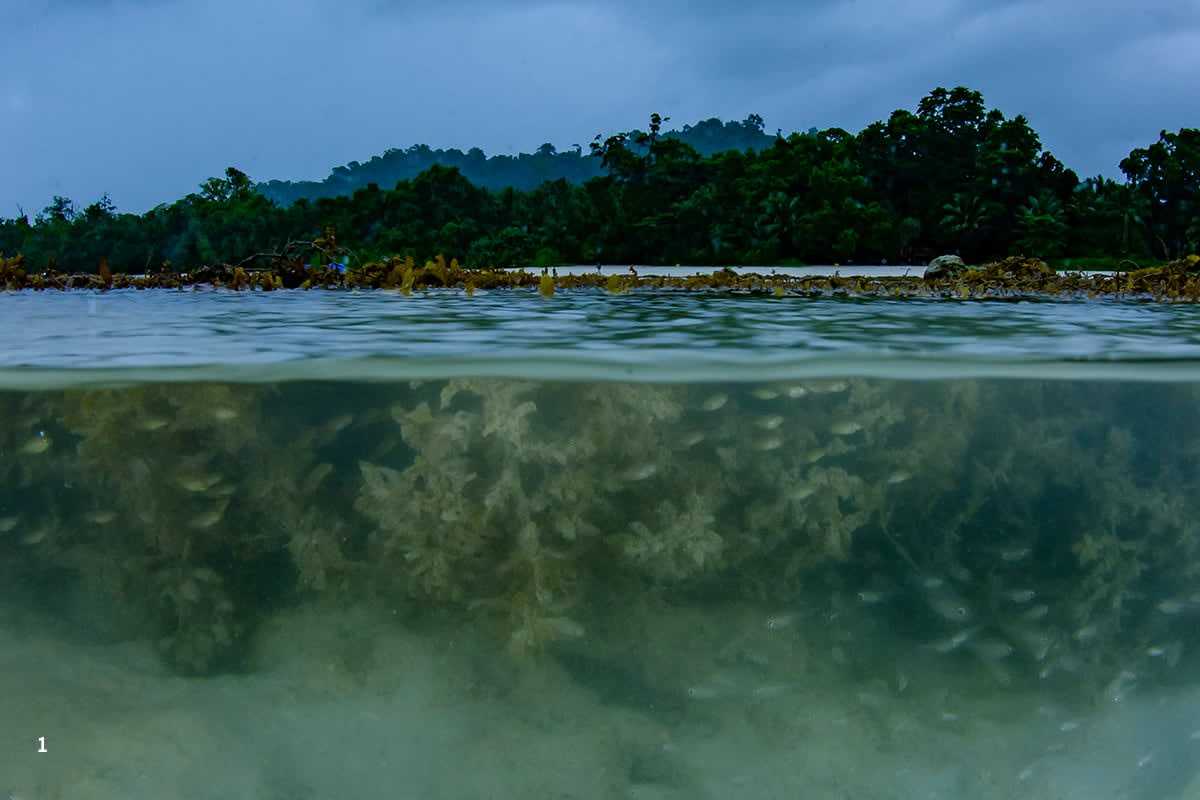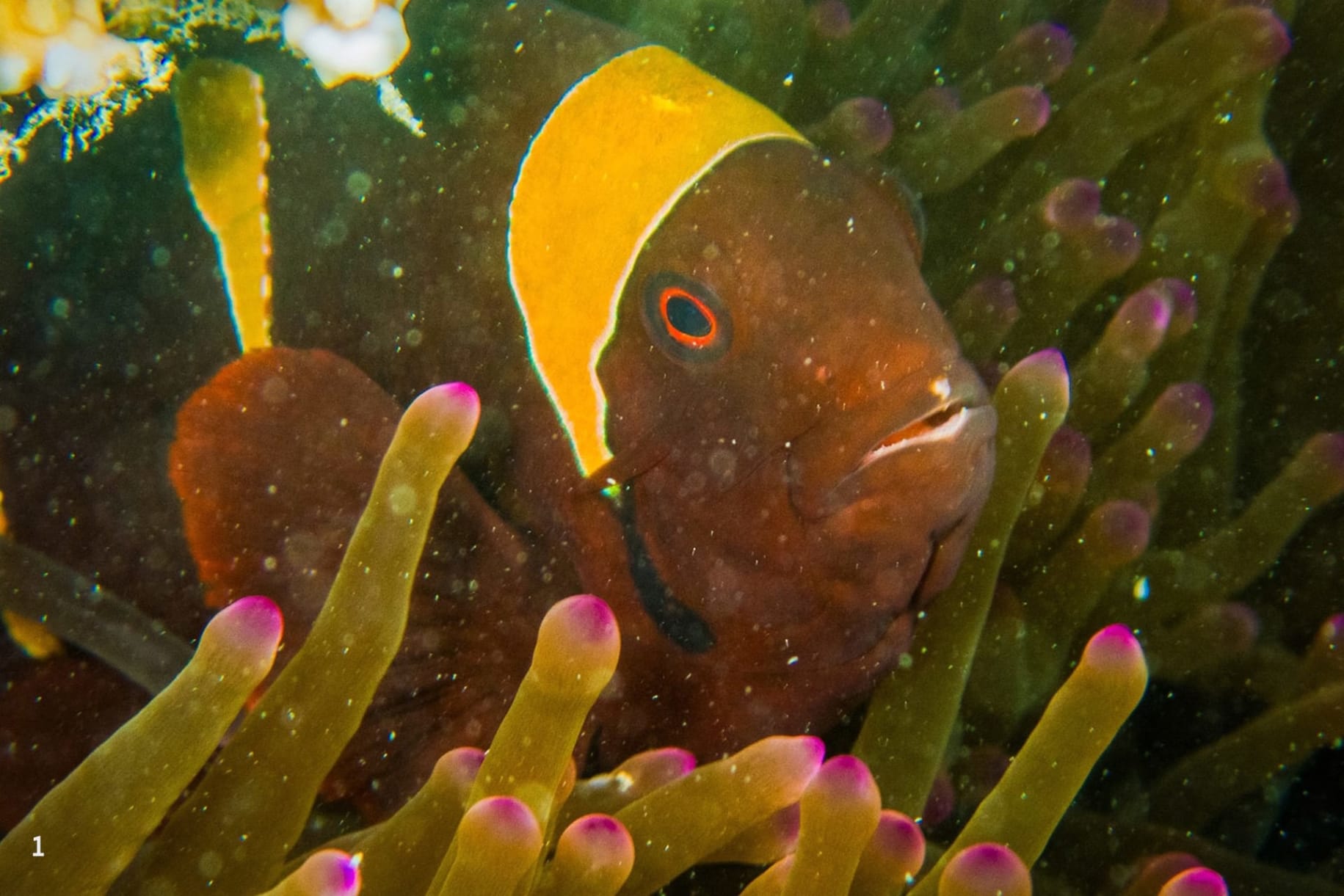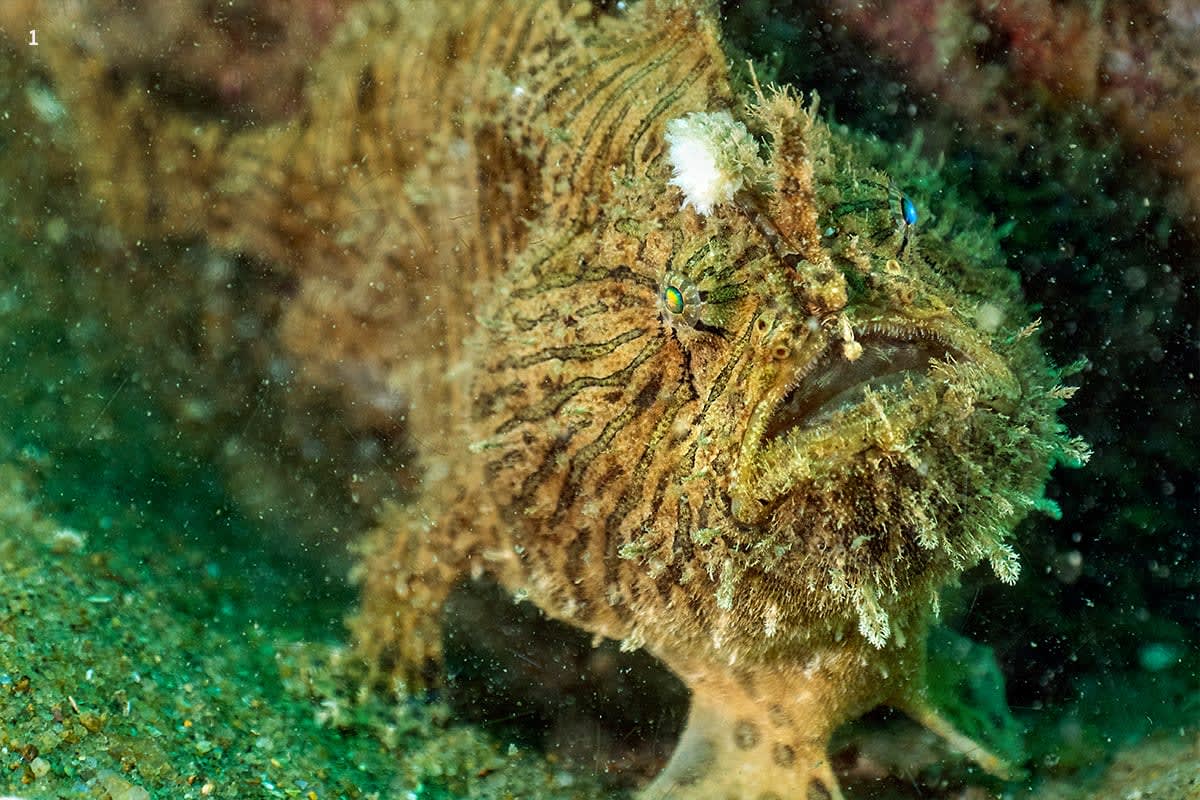 Listen to this article
•
15:34 min
Listen to this article
•
15:34 min
Diving or snorkelling are incredible ways to spend time with the marine life of the Andaman Islands. On days when the water is crystal clear, light from the sun pierces the blue water, and you can see for over 30 metres in any direction underwater — more than enough visibility to marvel at the ocean’s wonders. Schools of fusiliers move in columns, sharks and rays glide effortlessly in search of prey, and groupers perched on the reef seemingly watch the underwater party. There are days, however, when the water is dense with microscopic objects that scatter any light entering the water (turbidity). On very turbid days, it feels like you are swimming in a cloudy soup. Exploring the underwater world on a turbid day with just a couple of metres of visibility adds mystery to the ocean’s wonders. Look closely through the cloudy veil, and you will see life in the sand and amid the seagrasses and reefs with tightly packed schools of fish and packs of trevallies hunting them.
(1) A closer look at Havelock Island’s famous aqua-blue shores reveals a world of eerie sargassum forests and tiny fish suspended in cloudy waters. (2) Contributing to the cloudiness are millions of microscopic animals (zooplankton) like this copepod. Photos: Dhritiman Mukherjee (1), Umeed Mistry (2)
Cover video: At “The Wall,” a dive site off Havelock, a bluefin trevally hunting party emerges to hunt juvenile fusiliers. The turbid waters mute the silvery shimmer of the trevallies and allow them to get close to their prey. Video: Chetana Babburjung Purushotham
What’s in the soup!?
The turbidity is the result of a fascinating concoction of microscopic light-scatterers: calcium carbonate, clay, sand, and microscopic life (plankton and algae), each with their own role on life in the ocean.
Turbid waters are a natural consequence of the ocean being a vast ecosystem in flux. Biotic (living organisms) and abiotic elements (soil, water, air, etc.) are moved around by tides, currents, and waves in a delicate balance that sustains complex lives and processes in an unfathomably large body of water. For instance, calcium carbonate is a foundational mineral for shelled animals like clams, oysters, and calcareous algae. The same mineral is also the basic building block for corals to create their skeletal structures, eventually becoming majestic reefs that support nearly 25 per cent of known marine species. Marine clay and sand move through the ocean to create crucial habitats both in coastal areas and the deep ocean. The moving sands and clay particles also cycle fresh microscopic life, creating a vital food source for animals like clams, polychaete worms, and sand dollars.
Which brings us to plankton. If you look at a single drop of ocean water under a microscope at moderate magnification (~25X), you will see a kaleidoscope of life. Inspired by the Greek word planktos (drifter), plankton refers to all microscopic life forms in the ocean, tiny lives that go where the waters take them. The vast diversity of plankton is typically classified based on their role in the food web. Phytoplankton such as dinoflagellates, diatoms (microalgae) and cyanobacteria are photosynthetic primary producers; zooplankton are tiny animals such as fish eggs, worms, isopods, larvae of crabs and tunicates, among many others. In the microscopic food web of the ocean, there are also mycoplankton, like marine fungi and bacterioplankton (marine bacteria), that are critical to breaking down and cycling nutrients. Virioplankton are marine viruses that exist across the food web inside everything from mammals to bacteria. Viruses are one of the primary causes of death in marine microorganisms and consequently play a vital role as population regulators of the plankton world.
The soup that keeps on giving
These microscopic organisms are a crucial food source for filter-feeding animals of all sizes, from fragile feather stars to titanic blue whales. Most filter feeders are equipped with organs that act as sieves to filter plankton out of the water into their digestive systems. Baleen whales, for instance, have special plates in their mouth to sieve out plankton from large gulps of water.
Phytoplankton such as dinoflagellates, diatoms (microalgae) and cyanobacteria are photosynthetic, which means their food production results in oxygen being released into the atmosphere (roughly 50 per cent of the oxygen in our atmosphere comes from phytoplankton). This makes photosynthetic phytoplankton indispensable and vital to the health of all life on the planet.
Diatoms make up roughly half of all the organic material in the ocean; they extract nearly seven billion tonnes of silica from the water each year. These unicellular algae use the silica to create hard, porous cell walls (called frustules). Diatoms have, through millions of years of evolution, fine-tuned their photosynthesis game. Their frustules contain nano and micro-scale structures that enhance their ability to capture light for photosynthesis. While research for the use of these structures in solar cells is still nascent, Lyndsey McMillon-Brown and her coauthors at Yale University, in their study “Light-Trapping in Polymer Solar Cells by Processing with Nanostructured Diatomaceous Earth”, found a 30 per cent increase in the power conversion efficiency of solar cells coated with a microscopic layer of diatom frustules.
Soup of the bad kind
Turbidity is a natural phenomenon for the most part. It’s how a lot of vital minerals move from land into the sea. However, with human land use change, turbidity can become an unhealthily murky mix of sediments. Large-scale building projects, mining and other activities that uproot entire habitats also produce a lot of fine silt and dust. Rains carry these sediments from land to sea. The unnatural levels of minerals suspended in the water prevent sunlight from penetrating through the water and choke the life out of photosynthetic beings like phytoplankton, seagrasses, and algae. In a study titled “Effects of Sediment Exposure on Corals: A Systematic Review of Experimental Studies”, published in Environmental Evidence, Lillian J. Tuttle and her colleague found that excessive sediment concentration and prolonged exposure can have devastating effects on the health and life of corals. The suspended particles moved around by the water can damage the tissues of corals and their symbionts. Without adequate light, photosynthetic symbionts such as zooxanthellae that provide nutrition to many reef-building coral may eject themselves off the coral, leading to coral bleaching and eventually its demise.
One way to tell if the waters you are about to dive into are a good or bad soup, is to speak to members of the local community — fisherfolk, dive professionals, or anyone whose life and work is intertwined with the ocean.

Suspended in limited visibility
Diving or snorkelling in turbid waters lets you focus on tiny things close to you, such as a shrimp scuttling on an anemone. You become more aware of sounds, like the steady crackle of parrotfish chomping on coral or the popping punches of a shrimp nearby. One of my favourite turbid settings is diving at “The Wall”, tucked away in the depths of the channel between Havelock and Peel Islands. The waters of The Wall carry sediment run-off from Havelock, Peel, and a few neighbouring islands. Slowly descending into the underwater mist, you discern shapes as they get closer. Large schools of snappers and fusiliers huddled into compact schools look like dark animated shapes moving through the murky blue – the massive schools are visible from nearly ten metres away. The limited visibility urges the fish to form tighter schools that facilitate more efficient movements as a group, particularly helpful when faced with the threat of predators.
Watching closely packed fish schools is only half the treat on a turbid morning at The Wall. Suddenly, large, muted shimmers of silver fill the corners of your vision. Follow one of the silvery silhouettes long enough, and you will see a giant trevally cut through the school of fish like a knife through a balloon made of fish. Both the trevallies and the schools they hunt rely on their electro-sensing lateral lines to detect vibrations and electrical signals in the water to aid them. All of these create some of the most spectacular close encounters of the ocean kind.
A day underwater in turbid seas presents intrigue, builds mystery, and unveils a world of wonder just a few feet away.










